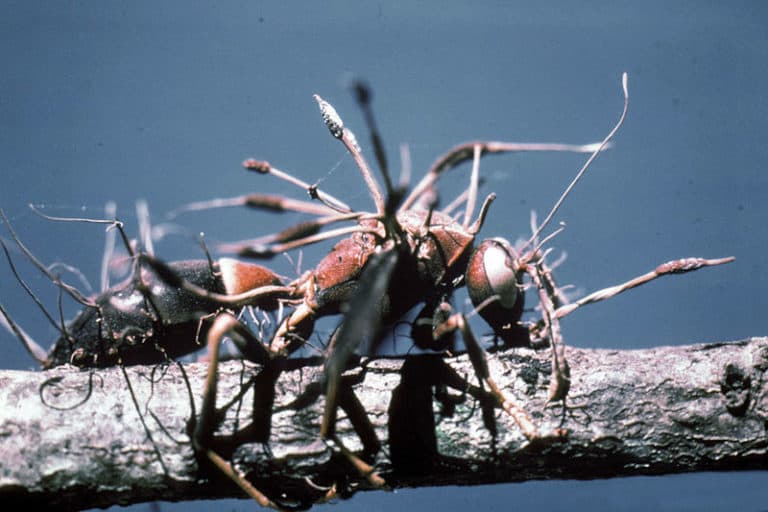What is a Food Safety Hazard?
A foodborne hazard is ‘a biological, chemical, or physical agent in, or condition of food with the potential to cause an adverse health effect’.
The definition is focussed very sharply on food safety considerations. This blog will describe and explain foodborne hazards according to this globally-accepted Codex definition.
Biological hazards include pathogenic bacteria, fungi, viruses, prions, protozoans, and helminthic parasites. Manifestations of these hazards typically involve foodborne illnesses with symptoms including gastrointestinal distress, diarrhea, vomiting, and sometimes death.
Chemical hazards include allergens, mycotoxins, heavy metals, pesticides, and cleaning and sanitation chemicals.
When ingested, these may cause gastrointestinal distress, organ damage, and immunological reactions that may result in death.
Long-term ingestion of foods containing toxic chemicals can lead to chronic effects, including cancer.

Physical hazards typically include materials that enter the food throughout its production chains, such as extraneous vegetable material, stones, bone fragments, wire pieces, broken glass, and wood splinters.
Their presence in food may result in choking or oral or internal cuts but rarely result in death.
What is not a Food Safety Hazard?
Many types of quality and regulatory defects that occur during food processing are not considered to be food safety hazards because they would not produce adverse health effect if such food were consumed.
Therefore, these defects are not identified as significant hazards during a hazard analysis, and they are not included in the HACCP plan.
Spoilage microorganisms may produce flavor, odor, and visual defects without making the food harmful for consumption.
Souring of milk, putrefaction of meats, gassing of liquid products, and the appearance of microbial colonies on the surface of foods are examples of quality defects.
Regulatory defects occur when a food does not conform to the requirements of particular regulations.
The presence of certain foreign materials, undeclared non-hazardous ingredients, extraneous vegetable material, or otherwise mislabelled product containers may violate regulations without representing an overt health hazard.
Similarly, diluting agents or other ingredients substituted as part of fraudulent activity may not be hazardous although, in this case, the unknown provenance of materials may mean that other unknown hazards could be present.
Bacterial Pathogens: Special Considerations and Features
Spore-Forming Bacterial Pathogens
Several genera of bacteria, particularly Clostridium and Bacillus, are able to produce endospores that are resistant to physical and chemical factors such as heat, dehydration, and acidification. They can survive in the environment for a very long time. Upon introduction into a food, the spores may germinate, enabling growth and/or toxin production by the pathogen. In addition, spores can survive heat treatments, grow, and produce toxin in suitable food.
Non-Spore–Forming Bacterial Pathogens
While illnesses caused by non- spore -forming bacterial pathogens usually result from the ingestion of large numbers of cells, several notable exceptions are described here. This group of pathogens is easily inactivated by heat, yet several of its members are hardy survivors in food processing environments, and one member produces a very heat-stable enterotoxin. All are facultative aerobes.
Salmonella spp. Salmonellosis is one of the most common bacterial foodborne illnesses and the second most common in the United States. Long recognized as being ubiquitous, salmonellae survive and grow very well outside of their normal habitat, the animal intestine. In particular, salmonellae survive very well in dry environments.
They have often contaminated food products that are processed and/or packaged in dry environments, such as dried dairy products, dried egg products, chocolate, soy flour, peanut butter, pet foods, and animal feed. Such contamination incidents are often caused by the unwise or inadvertent introduction of moisture into otherwise dry processing areas by means of wet cleaning and sanitation procedures, condensation, roof leaks, etc.
Typically, salmonellosis is caused in healthy persons by the ingestion of millions of cells. Much lower numbers of cells, about one hundred or less, can infect people who are immunocompromised. Healthy individuals can also be infected by such low numbers if the salmonellae are protected during passage through the stomach, particularly by high-fat foods such as chocolate or peanut butter, or if the pH of the stomach is increased by antacid therapy or a large quantity of food.
A global outbreak of illnesses that began about 30 years ago has been associated with shell eggs in which transovarian infection by Salmonella enteritidis leads to internal contamination of the egg yolk; however, the risk of this occurring has been reduced in several countries by flock vaccination.
Vibrio spp. Vibrios are halophilic microorganisms that thrive in warm marine or estuarine environments. They are a common part of the microflora of fish and seafood.
Cronobacter (formerly Enterobacter) sakazakii This microorganism is a prime example of an opportunistic pathogen. A common coliform bacterium, it can be detected in great many food and environmental sources, but it rarely causes illness.
It has been on very rare occasions found to be the cause of infection and death of premature infants. These rare infections are caused by mishandling (extreme temperature abuse) of rehydrated infant formula in the clinical setting. Nonetheless, a heavy burden to eliminate C. sakazakii in dried ingredients is rightly being placed on food processors that supply the producers of dehydrated infant formulas.
Viral Pathogens
Foodborne viral pathogens are obligate parasites that grow only in human cells. Therefore, the primary source of these viruses is human feces. Viruses are transmitted hand- to-mouth or by food handler contamination of prepared food, facts that have led to the ‘golden rule of food safety’: wash your hands! The major symptoms of viral foodborne illnesses are gastroenteritis and hepatitis.
Several zoonotic viruses are receiving attention in the food safety arena because of their potential to become foodborne.
Influenza viruses
Currently receiving the most attention are the H5N1 avian influenza virus and the H1N1 swine influenza virus. Foodborne transmission of avian influenza viruses will not occur if poultry is cooked to 70 While human influenza outbreaks, including widespread epidemics with many deaths, have confronted humanity since antiquity, avian influenza was first recorded in Italy in 1878.
Known then as fowl plague, outbreaks in birds became common, appearing in North America in the 1920s. A deadly epidemic in humans at this time was caused by influenza strain H1N1.
It has since spread through countries in Asia, Africa, and the Middle East. To this date, several hundreds of infected humans have died, whilst millions of birds have died or been culled to prevent the spread of the disease. Public health officials remain concerned that H5N1 could mutate into a more pathogenic form such as H1N1, thereby causing much larger outbreaks and mortality in humans who come into contact with infected birds.
In recent years, wild birds in many countries have been infected with a new strain of HPAI, H5N8. This virus and several related viruses were detected early in 2016 in 11 European and Asian countries in dead ducks, swans, gulls, geese, turkeys, and laying hens, and a Chinese farmer contracted H5N6 avian flu and died (National Wildlife Health Center 2016).
Similar infections have been detected in the United States in wild birds that travel the Pacific, Central, and Mississippi flyways (migratory bird paths); US Department of Agriculture. Whilst the infected wild birds have little impact on the human population, they can infect flocks of domestic birds. In the past two years, many infected commercial flocks were sacrificed at great cost to the growers.
Foot and Mouth Disease
Foot and mouth disease (FMD) is not a zoonosis because it does not infect humans. It is, however, of great economic importance to the food and agricultural industries. FMD is a severe and highly communicable disease of cloven-hoofed ruminants – cattle, sheep, goats, and deer – and swine.

FMD outbreaks are controlled by quarantine zones and the destruction of sometimes millions of animals, whether infected or not. In a world of increasingly limited resources, procedures to protect the food use of these animals could be developed, as the FMD virus does not infect humans and is inactivated by cooking.
Porcine Epidemic Diarrhoea Virus
Common in Europe and Asia for the past 40 years, the first case of porcine epidemic diarrhea virus (PEDv) occurred in the United States in 2013. It has since spread to 26 states, killing about 1 million pigs. The disease is much more severe in suckling pigs younger than 7 days old. It is characterized by a profuse, yellow, watery diarrhea. The pigs vomit, stop eating, become dehydrated, and die.
Infected pigs cannot be treated except with oral electrolytes. PEDv cannot infect humans; there is no health risk if pork products from infected pigs are accidentally consumed. (In any event, pork should be well cooked). The best means of prevention are strict biosecurity and sanitation. As a result of PEDv, many states have stopped showing pigs at county and state fairs.
Prions
Originally thought to be ‘slow virus diseases’ because of their long incubation periods, the causative agent was discovered to be not a virus, but a misshapen normal cellular protein called a prison . The infectious prion causes disease by catalyzing a change from normal to infectious state and the crystallization of prions in brain cells. With the destruction of sufficient brain cells, microscopic holes appear in the brain, hence the term transmissible spongiform encephalopathy (TSE).
Kuru
Kuru, a neurological disease that affected mostly the Fore tribes in New Guinea, became well known to the rest of the world when it reached its peak in the 1950s (Phillips 2016). Individuals became infected after eating the brains of dead family members as a way of paying respect to the deceased. As kuru can have a very long incubation period, the cause and effect of kuru were not understood earlier.
The study of kuru, the first neurodegenerative disease resulting from an infectious agent, led to the discovery and research on a new class of diseases that includes Creutzfeldt-Jakob disease, Gerstmann-Straussler-Scheinker disease, fatal familial insomnia, scrapie, and bovine and feline spongiform encephalopathies. These diseases of the brain affect primarily the cerebellum, which controls muscle coordination and balance. Their outcome is always fatal.
Scrapie
Scrapie, known for at least 250 years, affects the central nervous system of sheep and goats. Female animals sold from infected flocks can spread scrapie to other flocks. Scrapie can be transmitted to hamsters, mice, rats, voles, gerbils, mink, cattle, and some species of monkeys by inoculation.
There is no evidence – after 250 years – that it poses a threat to human health. Symptoms of the disease include scratching and rubbing against fixed objects, hence the name, scrapie. However, the disease has been transmitted throughout most of the world. Only two countries, New Zealand and Australia, are recognized by the United States as being free of scrapie.
Creutzfeld-Jakob Disease
Creutzfeld- Jakob Disease (CJD) is a TSE that regularly occurs throughout the human population at an incidence of about one case per million people each year and should not be confused with variant CJD, which, although unfortunately named, is linked to the BSE epidemic. Minnesota, population about 5 million, has 5 CJD deaths per year.
The United States, population about 320 million, has been recording about 300 CJD deaths per year. Minnesota and the United States have many people dying from CJD but have had little or no contact with BSE; only four cases have been detected in the past 20 years, during which time at least 6000 people died of CJD.
Parasitic Worms
Numerous tapeworms and roundworms are involved in foodborne infections. Most have long incubation periods and are associated with the consumption of raw or undercooked meat or seafood and raw fruits and vegetables, principally soil crops.
Biological Hazards, Zoonoses, and Food Chain Biosecurity Issues
Food biosecurity typically refers to efforts to protect animals from epidemic diseases such as avian influenza, FMD, BSE, etc. Global food trade can be diminished by the occurrence of such epidemics in the raising of domestic animals.
Existing biosecurity programmes also strengthen the foundation of food defense programmes. The protection of animals from epidemic diseases is also important because some zoonotic illnesses can be transmitted to humans. Some of the diseases (e.g. scrapie in sheep) have been known for several centuries, while others, such as BSE, appeared only about 20 years ago in 1986.
The control of animal diseases is necessary not only for animal health but also to protect human health and to maintain trade in the global food economy. The lack or poor administration of protective measures will lead not only to animal and human illnesses, but also to a loss of domestic and international sales, damaged reputations, and a decline in employment. As mentioned previously, biosecurity controls will also support food defense programmes.
Chemical Hazards
A very wide variety of chemical hazards may appear in food products either by natural occurrence in a raw material or by deliberate or unintentional addition during processing. The health effects of the chemical hazards can range from rather benign (e.g. residual cleaning compounds) to acutely toxic or carcinogenic (e.g. some mycotoxins or persistent organic pollutants).
Whilst chemical hazards require control because of their overt food safety risks, food producers must also contend with two additional consequences of the presence of unwanted chemicals – regulatory non-compliance and trade disruptions. This situation has become more complex because of different chemical residue limits around the world and the tendency to ‘chase zero’ when knowledge of threshold tolerances is not available.
Allergens
Allergens are naturally occurring proteins to which some persons develop hypersensitivity or immunological response. Concentrations of allergenic material as low as 1 ppm can induce responses in a matter of several minutes or less. Allergens affect up to 2% of adults and 7% of children. Symptoms range from rashes and nausea to anaphylaxis and death.
The principal global foodborne allergens are associated with groundnuts (peanuts), tree nuts, crustaceans, fish, eggs, milk, soybeans, and wheat. Regional allergens are associated with, for example, celery (European Union), buck-wheat (Southeast Asia), and rice (Japan) and numerous others.
Minor allergens include the seeds of cotton, sesame, sunflower, and poppy, as well as legumes and mollusks, and cross-reactivity with other allergens (e.g. reaction to apple in individuals who are sensitive to birch pollen) can cause further problems for sensitive consumers.
Properly-refined oil produced from allergenic seeds is not itself allergenic, as all of the proteins have been removed. Allergen hazards may be introduced during food processing by poor control of reworked materials, the addition of the wrong ingredient to food, or mislabelling of the consumer product. They may also be introduced by cross-contamination during food preparation in the home or foodservice operations.
Mycotoxins
Ergotism is an illness that has been known for millennia, long before awareness of mycotoxins emerged in 1961. Ergot is produced during the growth of Claviceps purpurea in grassy cereal groups such as rye, oats, wheat, and barley.
It is contained in sclerotia that range in size from mouse droppings to several centimeters. The threat of egotism can easily be avoided by proper grain-handling practices.
Thousands of mycotoxins are produced as secondary metabolites during mold growth. They can enter the food supply when substantial mold growth occurs in field crops. Most mycotoxins are produced by only three mold genera – Aspergillus, Fusarium, and Penicillium.
Aflatoxin, named after A. flavus, was discovered after contaminated feed caused the deaths of turkeys in the United Kingdom in 1961. Since that time there have been numerous animal feed recalls due to aflatoxin, particularly in horse feed given their sensitivity to this particular contaminant.
It is a potent liver carcinogen. Aflatoxin is a normal hazard in peanut crops during wet years and in corn (maize) crops during dry years when drought-stressed plants are vulnerable to mold infestation.
Patulin can be produced in damaged fruits, particularly apples. Therefore, it is of some concern in products such as apple juice.
Ochratoxin can be produced during mold infestations of wheat, corn, or oats. It can contaminate the meat or milk derived from animals that consumed ochratoxin-contaminated grains. It is of most concern in Africa and the European Union.
Zearalenone, sometimes produced in grain crops, is a mycoestrogen that can disrupt steroidal hormone functions.
Marine Foodborne Toxins
Shellfish Poisoning
Several illnesses are associated with bivalve mollusks such as mussels, clams, and oysters. The mollusks filter large quantities of seawater, thereby concentrating pathogenic dinoflagellates or diatoms that produce a number of toxins. Illnesses caused by contaminated mollusks are more likely during red tides.
Diarrhoeic shellfish poisoning results in mild gastroenteritis, also caused by dinoflagellates.
Neurotoxic shellfish poisoning is a gastrointestinal illness with a low fatality rate. It is caused by brevetoxin, produced by the dinoflagellate Gymnodinium breve.
Amnesic shellfish poisoning, also called domoic acid poisoning, begins as gastroenteritis and can proceed to neurological symptoms, coma, and death. First recognized in 1987, it is caused by the genus Pseudonitzchia, a diatom that produces domoic acid.
Finfish Poisoning
Ciguatera poisoning is caused by ciguatoxin produced by the dinoflagellate Gambier discus toxins. It can be associated with about 400 species of tropical fish. Ciguatoxin also causes gastroenteritis and can proceed to neurological symptoms and death.
Scombroid (or histamine) poisoning is associated with a family of fishes, involving most often tuna, mahi-mahi, and mackerel, that contain high levels of free histidine in their flesh. Proteus spp. can grow on improperly chilled fish, decarboxylating histidine to histamine, which produces symptoms that mimic an allergenic response.
Puffer fish (fugu) poisoning is caused by tetrodotoxin, an often lethal neuroparalytic toxin that is produced in the liver or internal organs of the puffer fish by several genera of Gram-negative bacteria including Vibrio, Alteromonas, Aeromonas, Plesiomonas, Pseudomonas, and Escherichia. It has typically been reported in Japan and Southeast Asia due to the inadequate removal of the internal organs during food preparation.
Genetically Modified (GM) Foods
Genetic modification is the alteration of an organism by the introduction into its genome, or chromosomes, of one or more genes from a different organism. Numerous crop applications have been developed to prevent plant diseases without using chemical pesticides (BT corn) or to reduce herbicide applications (herbicide-resistant soybeans).
Originally, theoretical public health concerns regarding the potentially altered allergenicity of GM crops were raised. At this point, there is no indication that GM foods are unsafe. In the interests of due diligence, however, food safety assessments need to be conducted on all new GM applications.
Whilst no overt food safety issues have been identified with GM foods, major logistical and regulatory difficulties can be caused by the need to segregate GM from non-GM crops, and in the labeling of GM-containing consumer foods.
Antibiotics
Potential food safety and public health issues related to the presence of antibiotic residues in food are not well understood. The hypothesized concern is that the use of antibiotics in animals, either therapeutically or as growth promoters, may give rise to the occurrence of antibiotic-resistant pathogens in the food supply or in humans.
Therefore, when therapeutic antibiotics are used to treat animal diseases, adequate clearance times before harvesting are enforced by veterinarians to prevent human consumption of the antibiotic.
Persistent Organic Pollutants (POP)
Several thousand complex chemicals have been synthesized since the 1930s for use as pesticides or industrial chemicals. These are generally chlorinated or brominated aromatic compounds that are very resistant to microbial or chemical degradation.
Therefore, they persist for a very long time in soil and sediments. Most of these compounds are lipophilic, bioaccumulating in fatty tissues in the food chain. Because many of the compounds are volatile, they can be airborne for great distances from their point of use.
POPs in aquatic sediments can be accumulated in algae and plankton, which in turn are ingested by fish. Humans and other animals further accumulate POPs when eating contaminated fish. In the 1960s, birds of prey became nearly extinct because DDT accumulated in fish reduced the birds’ eggshell thickness.
On land, POPs carried by air can contaminate forage which is consumed by grazing animals. The meat or milk from these animals can transfer the POP to humans. In humans, POPs may elicit chronic effects. They are known or suspected carcinogens and can function as a sex hormone, endocrine, or immune system disruptors.
Pesticides. Aldrin, Chlordane, DDT, Dieldrin, Endrin, Heptachlor, Mirex, and Toxaphene are applied to a wide variety of crops. They must be applied according to the proper schedule. Crops cannot be harvested until the prescribed clearance period has elapsed.
Industrial chemicals and contaminants: Hexachlorobenzene (HCB) and polychlorinated biphenyls (PCB). Used as a fungicide in crop seeds such as wheat, HCB causes human illness when the seed grain is mistakenly used as food, even though the treated seeds are colored to discourage consumption.
PCBs are used in industrial applications, such as coolants in electrical transformers. The inadvertent or deliberate contamination of feed-grade oils or fats with transformer fluid can occur. The US action level for PCBs in red meat (fat basis) is 1 ppm.
Dioxins. The principal human exposure to dioxin is through consumption of contaminated fish, meat, or dairy products.
The contamination of fats used in animal feed with industrial oil led to a massive recall of food products because of dioxin contamination in Belgium in 1999. The European Union has established action levels for dioxins in human food and animal feed ranging from 0.5 to 4.5 ppt.
Heavy Metals
Heavy metals in the food can have a wide variety of toxic effects in humans and animals including tunnel vision, deafness, chronic brain damage, congenital defects, peripheral neuropathy, hyperkeratosis, nephrotoxicity, and skin cancer. Heavy metals typically enter the environment from industrial effluents, coal-fired power plants, and municipal garbage incinerators.
Mercury. Historically recognized as the cause of ‘mad hatter’s disease’, metallic mercury is transformed to methyl mercury in marine and freshwater environments. It is bioaccumulated in the food chain in the same manner as POPs.
Methyl mercury-treated seed grain, when mistakenly used as food, has been responsible for foodborne illnesses. Mushrooms obtained near mercury and copper smelters often cause illness. The United States has an action level of 1.0 ppm for methyl mercury in fish, shellfish, and wheat.
Lead. Lead poisoning can be caused by ceramic ware used for serving food. In addition to neurological symptoms, lead can also cause kidney damage. The action level in various types of ceramic ware ranges from 0.5 to 7.0 ppm.
Cadmium. Sometimes associated with rice, cadmium is nephrotoxic. It can also be associated with ceramic ware, for which action levels of 0.25 to 0.5 ppm have been established (FDA 2000).
Arsenic. Used in various compounds as a rodenticide or fungicide, arsenic is a well-known human poison. Chronic exposure can result in cancer or skin lesions.
Arsenic naturally found in rocks or minerals can be released into the groundwater by biological or chemical processes. Whilst groundwater contamination with arsenic occurs globally, it is thought to be a more serious problem in Southeast Asia.
Chemicals Used in Food Processing Environments
A great number and variety of chemicals are used in food processing plants for the routine operation, maintenance, and cleaning of the processing equipment.

Care must be taken to prevent cross-contamination of food materials with the chemicals used in food processing environments. Representative chemicals include boiler additives, lubricants, refrigeration fluids, detergents, sanitizers, and pesticides.
Chemicals Used in Food Packaging Materials
Care must be taken in the selection of food contact packaging materials, as plasticizers and additives used in their manufacture may leach into the food product. Adequate knowledge of the chemicals used and their toxicity should be obtained.
For example, in 2008, research was begun to understand the public safety impact of bisphenol A that leach into water and foods packaged in polycarbonate plastic bottles or metal cans that had been manufactured with the use of bisphenol A. Testing procedures, requirements, and standards for the migration packaging additives into foods have been published in England.
Unanticipated Potential Chemical Hazards
The myriad of naturally-occurring and synthetic chemicals can interact in foods to create derivatives or analogs that may come under suspicion as foodborne hazards. At these times, food safety and public health professionals sometimes need to act quickly in order to assess and control the potential hazard.
Acrylamide has long been used to synthesize polyacrylamide, which is widely used for water treatment, soil conditioning, laboratory applications, and in the production of paper, textiles, and cosmetics. The WHO guideline for acrylamide in drinking water is 0.5 ppb. Also produced in cigarette smoke, acrylamide has neurotoxic effects in humans and animals.
The serendipitous discovery in 2002 by the Swedish National Food Authority of acrylamide in foods caused temporary alarm throughout the food industry. It was determined that acrylamide is formed when glucose and asparagine interact during the baking or frying of foods at temperatures above 120.
The production and trading of adulterated or counterfeit foods are criminal acts in most countries. Such acts undermine confidence in the safety of the food supply and must be handled swiftly and firmly to discourage further incidents. In November 2009, the Chinese government executed a dairy farmer and a salesman and jailed 19 others for their roles in the melamine contamination of milk.
Physical Hazards
Foodborne physical hazards are commonly called ‘foreign materials’ or ‘foreign bodies’ because their presence in food is unnatural. Foreign materials in food can be potentially harmful or merely undesirable.
Sources of Foreign Material
Foreign material can enter foods at almost every point of the food supply chain. The general sources of contamination are the environment, the food itself, the food processing facilities, and personal objects.
Soil and stones are typical environmental contaminants during harvesting. During harvesting or by later infiltration, food may be contaminated by insects, rodents, or reptiles. These may be disintegrated during harvesting or processing so that body parts or excreta are the residual evidence of contamination.
When testing blood samples of workers in the acrylamide industry, the Swedish authority found similar levels of acrylamide in a set of control workers who had no industrial exposure, leading to its discovery in certain foods.
Some foreign material contamination originates with the food itself. Examples include fruit pits, stones, and stems; bones or bone chips from fish and meat; pieces of corn cobs; nut shells; and hardened or crystallized sugars.
A great deal of foreign material contamination originates in food processing facilities. Metal shavings, nuts and bolts, and lubricants from the processing equipment can enter the food. Nails, cut wires, and broken utility blades can be dropped into the food stream by maintenance workers.
Pieces of glass, hard plastic, and wood splinters can enter the food from other fixtures and utensils in the processing area.
Personal objects used or worn by maintenance and line workers and by food handlers in foodservice operations often fall into the food. These may include rings, pencils, papers, earrings, nose rings, buttons, thermometers, hair, and gloves.
Injuries Associated with Physical Hazards
Because of their relatively low occurrence and severity, foreign materials are often not considered to be significant hazards in foods. Whilst most incidents of foreign material ingestion do not result in overt bodily harm, up to 5% of such incidents do result in injury.
Slender, pointed objects such as bone slivers and glass shards are the most hazardous. These can cause oral or gastrointestinal lacerations or perforations. Sharp foreign materials about 2 to 5 cm long are most likely to be involved in intestinal perforations. In these rare cases, subsequent abdominal infections can result in death.
It is generally considered that objects smaller than 7 mm in their longest dimension are not likely to cause injury in adults, as these can pass through the digestive tract without causing harm. However, some particles less than 7 mm may cause harm in infants. Because it is readily softened in the food or upon ingestion, the paper is usually not considered to represent a risk of injury.
Many small toys and other objects are marketed with food products to increase their appeal to children and their parents. Objects that are less than about 3 cm in diameter or 6 cm long can present a choking hazard for infants and small children. Larger objects that cannot be swallowed do not present a choking hazard.
Some foods (e.g. grapes or pieces of meat) due to their physical condition (size and shape) may present a choking hazard for small children. For certain animals (older horses are especially vulnerable), choking can also be a significant hazard due to the absence of a reflux mechanism.
Conclusions
Complete awareness and understanding of the potential biological, chemical and physical foodborne hazards must be maintained by product development teams, food safety managers, and HACCP teams.
Such knowledge is necessary to conduct product and process research and to conduct a responsible hazard analysis and determination of the appropriate control measures that will need to be implemented at critical control points and in prerequisite programmes.
All food safety professionals must also remain vigilant in order to be able to quickly respond to unanticipated hazards. ‘Expecting the unexpected’ is an underappreciated aspect of food safety management.






